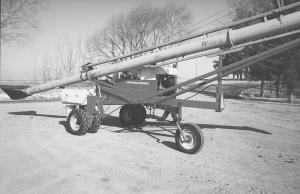2002 - Volume #26, Issue #3, Page #28
[ Sample Stories From This Issue | List of All Stories In This Issue | Print this story
| Read this issue]
Self-Propelled Grain Auger Mounts On Old Swather
 |
"It still worked fine but it was old. Nobody wanted it for any price," Jerry says. So the machine sat parked in the corner of the shed, taking up space. Then one day, in a fit of creativity, the men hit on the idea of mounting their 44-ft. 10-in. Westfield grain auger on it.
"We'd always thought about putting an engine on the auger so we didn't have to have a tractor to run it," De Blonde says. "By mounting it on the old swather, we figured we wouldn't need a tractor to move it around, either."
They removed the cutting table from the swather and the wheels from the auger. Then, using pieces of the auger support frame and scraps of steel bar and angle iron they had around the shop, they fashioned new mounts to hold the auger tube on the swather. A lift cylinder from an IH 914 combine lifts the top end of the auger. A header lift cylinder from the old swather raises and lowers the hopper end.
"We can raise it off the ground enough to maneuver it into grain bins to clean them out," De Blonde says.
To drive the auger, they used the pulley that originally drove the cutter bar. "We mounted a jackshaft on the swather with a pulley that lined up with the existing pulley. We replaced the pto shaft from the auger with a longer telescoping shaft with universal joints and attached that to the other end of the jackshaft. That way, as we raise and lower the ends of the auger, the shaft can flex and extend or shorten, so everything stays in line," he explains.
He says they had to do a little experimenting to find the right sized pulley for the jackshaft, in order to run the auger at the right speed. "We ended up with a 16-in. pulley on it," he adds.
"It took a bit of time to figure out how to attach everything, but when we were done with it, it worked great. We did have to add some weight to the front of the swather to counterbalance the weight of the auger hanging out behind it. The belt drive transmission lets us go as slow as we want to move it into position and disengages completely, unlike a hydrostatic transmission, so it doesn't tend to creep once its set. And the swather's existing lighting lets us use it at night if we need to."
Contact: FARM SHOW Followup, Jerry De Blonde, Box 132, Swan Lake, Manitoba R0G 2S0 Canada (ph 204 836-2726).

Click here to download page story appeared in.

Click here to read entire issue
To read the rest of this story, download this issue below or click here to register with your account number.




